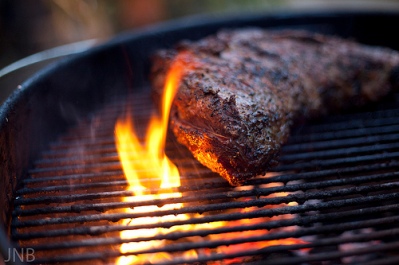I’ve been on a bit of an Asian flavor kick lately – so this recipe probably won’t surprise you. 🙂 These bowls are nothing but goodness with lovely spiced beef, starchy sweet potatoes, and lots of garnishes.
- 6 garlic cloves, minced
- 2 tablespoons grated ginger root
- 1/4 cup chopped, fresh cilantro
- 1/4 cup coconut aminos
- 1 teaspoon sesame oil
- 1/2 cup rice vinegar or coconut vinegar
- 1/4 cup extra-virgin olive oil
- 1/2 teaspoon red pepper flakes
- 2 packet stevia or 4 tablespoons honey, divided*
- 1 pound flank steak, hanger steak, or flat-iron steak, cut into 1/2 inch thick strips against the grain
- 1 cucumber, julienned
- 4 tablespoons coconut oil, divided
- 2 sweet potatoes, cubed
- 1 carrot, julienned
- 1/4 cup bean sprouts
- 3 green onions, thinly sliced on the bias
- 2 eggs
- Sea salt and freshly ground black pepper
- In a food processor, combine the garlic, ginger root, cilantro, coconut aminos, sesame oil, 1/2 cup of the vinegar, olive oil, red pepper flakes, and 1 packet of the stevia or 2 tablespoons of the honey. Process until pureed.
- Place the strips of steak in a gallon sized plastic zipper bag and add the marinade. Seal and refrigerate for eight hours.
- In a small bowl, combine the remaining 1/4 cup of vinegar with 1/2 teaspoon of sea salt and 1 packet of stevia or two tablespoons of honey. Add the cucumber. Refrigerate for a few hours.
- In a large skillet, heat two tablespoons of the coconut oil on medium-high. Add the sweet potatoes and cook, stirring occasionally, until browned, about ten minutes. Set aside tented with foil.
- In the same skillet, heat the remaining two tablespoons of coconut oil on medium-high. Remove the beef from the marinade and pat dry with a paper towel. Cook the beef in the hot oil until cooked through, about five minutes.
- In a small nonstick skillet, fry two eggs, sunny side up or easy over. Season with salt and pepper.
- To assemble the bowls, divide the sweet potatoes into two bowls. Top with the beef, the carrots, the pickled cucumber, the been sprouts, and the green onions. Top with the fried egg.
*For Whole30, omit the honey and stevia and instead add 1 chopped medjool date to the marinade and omit any sweetener from the cucumber pickle.
photo credit: Dolsot bibimbap @ L’Arbre de Sel @ Montparnasse @ Paris via photopin (license)

 by
by  by
by  by Karen Frazier
by Karen Frazier by
by  by
by 
 by
by  by
by  by
by  by
by